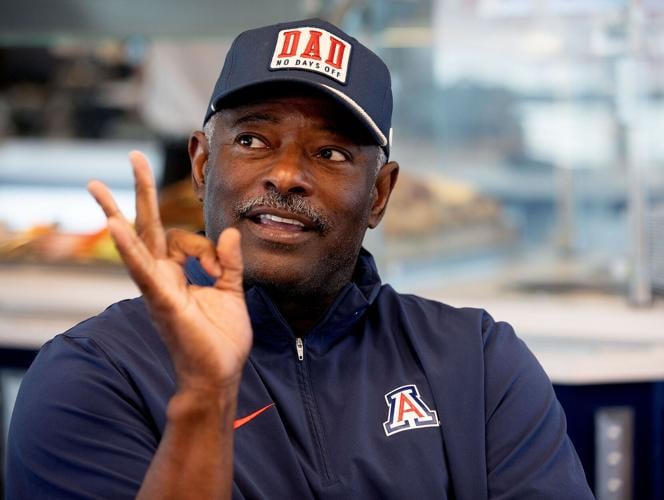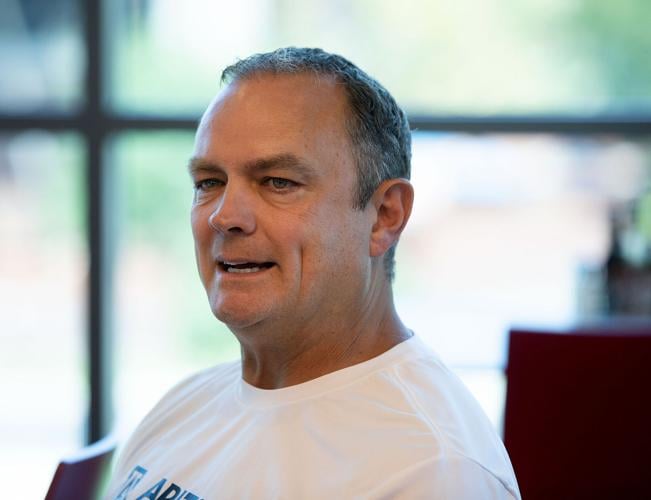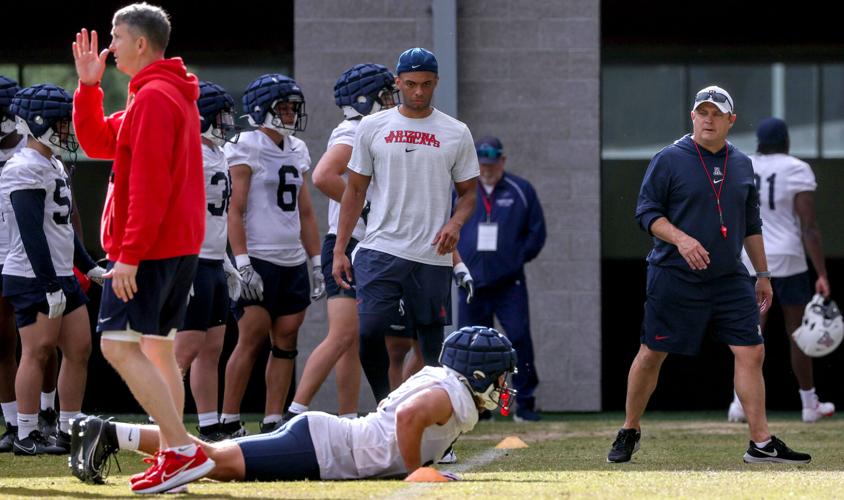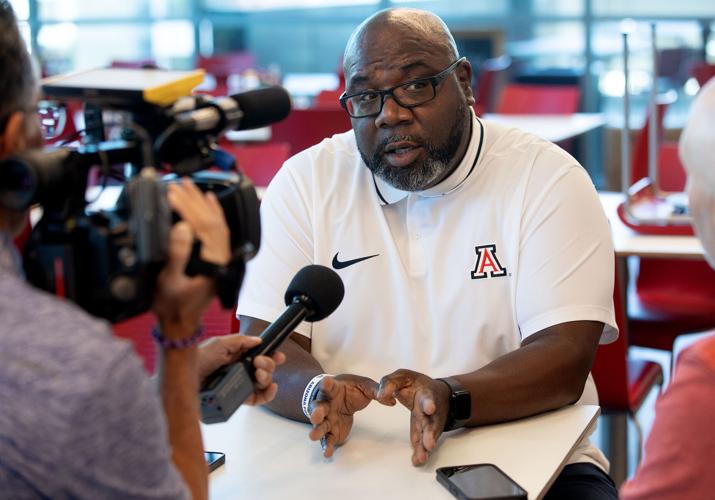We’ve all seen the videos. They never get old.
The coach gathers the team for a meeting. He calls up a walk-on under some false pretense. He then reveals that the walk-on has earned a scholarship.
The player bursts into tears. His teammates go berserk.

Michael Lev is a senior writer/columnist for the Arizona Daily Star, Tucson.com and The Wildcaster.
It’s an uplifting, inspirational moment. And it works every ... single ... time.
“It’s so pure,” said Arizona offensive coordinator Dino Babers, a former head coach at Syracuse, Bowling Breen and Eastern Illinois. “Definitely the American way.
“I want to say that we’re gonna always have that, and I don’t ever want to give it up.”
What could lead to the demise of those magical moments? The end of walk-ons as we’ve known them.
The viability of walk-ons has been a hot topic in college football since details of the settlement in the House vs. NCAA case were revealed late last week. They included, but were hardly limited to, roster limits across multiple sports.
For football, the new number is 105 — all of whom can be on scholarship if a program has the means and desire to foot that bill. It might be only a handful that do — although peer and fan pressure can be powerful forces. If ASU fully funded 95-100 football scholarships — and Arizona only 85-90 — UA fans probably wouldn’t be super thrilled. Some might call that billboard material.
On the surface, going from a maximum of 85 scholarships to 105 seems like a win for the players. Even if, on average, programs added just five scholarships, that’s 670 spots across FBS. That’s not insignificant. It’s unquestionably a net gain.
But something could be lost in the process.
No program in college football is more renowned for its walk-on program than Nebraska. The Cornhuskers currently list 151 players on their online roster — which means, by definition, that 66 are walk-ons.

Arizona head coach Brent Brennan, far left, and assistant coach Danny Gonzales, far right, both began their college playing careers as walk-ons.
The new roster limits are expected to be implemented in 2025 — which means, by decree, that 46 of these players no longer would have spots on the NU roster.
Arizona listed 108 players on its roster on the eve of training camp, which officially begins Wednesday morning. As Brent Brennan tells it, that’s par for the course.
“For me, a roster of 105, that’s SOP (standard operating procedure). That’s what it’s been. That’s what you brought to camp,” Brennan said Tuesday during a news conference to preview training camp. “I was never at a school that either had a budget or could comply Title IX-wise to take that roster to 130 or 140 like some schools do. I’ve never experienced that. So we had to find ways to win football games with 105 every place I’ve ever been basically.”
For many schools — a clear majority, per Babers — having 105 players isn’t much of a change. It’s the composition of the rosters that could be significantly different.

Danny Gonzales, special teams coordinator and linebackers coach for the Arizona Wildcats football team, answers questions during a preseason event at Arizona Stadium on July 30.
At a place like Nebraska or Ohio State or Georgia — where former walk-on Stetson Bennett IV led the Bulldogs to a national championship — the walk-ons could get nudged out.
UA linebackers and special-teams coach Danny Gonzales — who, like Brennan, began his college playing career as a walk-on — believes that college football will self-correct. The high school players who can’t resist a scholarship offer from Alabama or Michigan will transfer once they realize they aren’t actually playing as the 86th or 104th man on the roster, Gonzales said. That’s no different than the way things are now.
“People love playing football,” said Gonzales, who spent the past four seasons as the head coach at New Mexico. “The opportunity to go to those places the first year to some kids is going to make a difference. But I think Year Two, Year Three, Year Four, they’re going to go back to where they would have been anyway.
“The majority of kids are in this to play football because they love football. They want to play. Nobody wants to sit on the bench.”

Alonzo Carter, running backs coach for the University of Arizona football team, answers questions during a preseason media luncheon at Arizona Stadium Tuesday.
Walk-ons, for the most part, have a different mindset. They are the overlooked underdogs. The chips on their shoulders are the size of boulders. Ever seen highlights of Chuck Cecil?
“That’s what college football is about. That’s what life is about — overcoming obstacles,” said UA running backs coach Alonzo Carter, who also began his college playing career as a walk-on. “A lot of times you’re betting on yourself. You’re saying, ‘You know what? I think I can do this. I’m gonna walk on, pay my own tuition ... bet on myself and give myself a chance to earn a scholarship.’
“In our seven years at San Jose State, we had a quite a few young men that earned that opportunity, and it was just a blessing to see that happen.”
Babers and Gonzales shared stirring stories about walk-ons who went on to do great things.
While playing for Dick Tomey at Hawaii, Babers was asked to accompany an assistant coach to a walk-on tryout.

Arizona offensive coordinator Dino Babers answers questions during a preseason media luncheon at Arizona Stadium on July 30.
“He started backpedaling and he fell down,” Babers said.
The assistant coach started laughing. Babers stood up for the player.
That player was Rich Miano, who would become an all-conference performer and 10-year pro in the NFL.
Babers believes there always should be a place for players “that people say can’t get it done and they’re gonna prove people wrong. I’m always pulling for those guys.”
While coaching special teams at New Mexico in 2007, Gonzales put his job on the line by putting his faith in walk-on kicker John Sullivan. Sullivan missed two field goals in a 10-6, season-opening loss to UTEP. Head coach Rocky Long was none too pleased. Sullivan struggled in warmups before the next game as well.
“It was awful,” Gonzales said. “I’m like, ‘Look, man, I believe in you.’ I gave him a dollar bill. I said, ‘Put this in your shoe. You will not miss again. You’re good.’ ”
Sullivan set a school record that season by making 29 field goals in 35 attempts. At one point, he made 18 in a row.
“A walk-on kid that had no chance of playing ended being a consensus All-American,” Gonzales said. “It’s awesome. Just awesome.”
Sullivan is now an associate commissioner in charge of football for the Mountain West Conference. Who knows where he’d be now if he didn’t get that opportunity back then?
That’s Dabo Swinney’s argument. The Clemson coach isn’t sure he’d be who is if he hadn’t walked on at Alabama and developed a relationship with Gene Stallings, who gave him his start in the business.
“I can’t even imagine how different things would’ve been,” Swinney told reporters at ACC Media Days.
It’s hard to imagine college football without a walk-on component. The success stories are countless. J.J. Watt was a walk-on. So were Clay Matthews and Baker Mayfield and Luke Falk.
Maybe it’s just a matter of semantics. The new setup allows football programs to award partial scholarships, according to reports. The players who used to walk on might be able to get a little something. That’s a positive for that pool of prospects.
But in those team-meeting videos that never get old, I’m not sure that “You’re on full scholarship!” hits quite the same.
Arizona head coach Brent Brennan spoke with media at Lowell-Stevens Football Facility leading up to the start of UA football training camp. (Video by Justin Spears)








